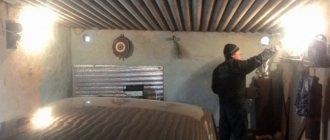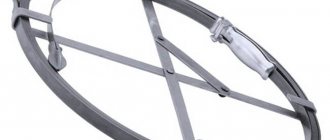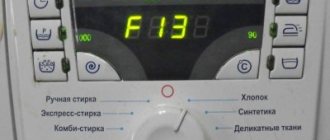The formation of water droplets and a water “film” on pipes in the toilet and bathroom is a common and annoying problem. The appearance of moisture is due to the fact that water vapor present in the air condenses on the coldest objects in the room - usually these are pipes with cold water. At first glance, there is nothing terrible about this, but constant puddles under the pipes do not add order to the bathroom and can cause mold and rotting of materials. Therefore, it is better to remove condensate on cold water pipes.
Why is it formed?
Condensation is expressed in the appearance of small drops of water or complete wetness of the surface of pipes with cold water.
There are only two main causes of condensation:
- an increase in air humidity caused by the appearance of a source of active evaporation of water;
- the appearance of colder surfaces, changing the temperature ratio and causing moisture to settle.
The conditions for the appearance of condensation are a combination of these factors, enhanced by a large difference in temperatures.
For example, if a constantly wet surface is heated, it will stop attracting water vapor.
Conversely, if it is cooled sharply, the appearance of condensation will become inevitable. This phenomenon in itself is not a sign of any dangerous or undesirable processes. Attention! Condensation is dangerous due to its consequences - moisture begins to be absorbed into the wall materials, dampness and mold appear, steel elements are destroyed (fasteners, plumbing parts, when penetrating deep into the concrete, the fittings begin to rust).
In the bathroom
The appearance of condensation in the bathroom can have various reasons:
- Immediately after taking water procedures (especially after a hot shower) is normal. If moisture covers all surfaces - tiles, mirrors and other cold surfaces, but quickly evaporates (in normal conditions this process takes only a few minutes), there is nothing to worry about. This indicates that the room has normal ventilation, which actively removes water vapor.
- Leaking hot water or hot water pipeline .
They are much more dangerous, as they pose a risk of flooding of the apartment, and not only your own. A particularly dangerous sign is a leak in a hot water pipe. This is evidenced by the constant appearance of steam in one area or another of the room. Hot water evaporates more actively and creates increased humidity in the air. Cold water pipes, on the contrary, attract condensation. If there is a leak (not necessarily in the pipeline itself, a possible cause could be a valve that is not closed tightly), the pipe is constantly wet.
In the toilet
In the toilet, condensation appears on the cold water pipes and on the flush tank (less often on the toilet itself).
The main reason is incorrectly configured tank mechanics , which creates a constant leak.
It is noticeable if you look closely at the upper area of the water outlet in the toilet bowl.
Reference! Most often, the problem can be resolved by adjusting the tank. As soon as the constant flow stops, moisture settling will noticeably decrease or stop altogether.
On the riser
Condensation on the riser indicates the appearance of a constant water leak either in your apartment or in the apartments of neighbors on the upper floors. The water does not stagnate and does not heat up, so the temperature of the riser is noticeably lower than that of surrounding objects.
If the water vapor content in the air is increased, the surface of the pipe will immediately become wet. If the reason lies in your apartment, eliminating it will not be much of a problem. It is worse if a constant leak occurs on the upper floors of neighbors, since it is sometimes extremely difficult to determine the source and somehow influence the residents.
Use of chemicals
If it is necessary to protect the pipeline from the formation of condensate drops on its surface, you can use special means: Asstratek, Stermizol, Corundum, etc. They are used as follows:
- The surface of the pipe is cleaned of dirt and rust. To do this, it is wiped or sanded.
- To make the mixture adhere better to the surface, it is coated with a primer.
- Using a brush or spray bottle, the substance is applied to the surface. It is advisable to apply at least 4-5 layers to be sure that droplets of moisture will no longer appear on the riser.
- To increase the service life of the pipeline, a fixative is applied on top of the insulating material.
Thermal insulation of pipes with mineral wool Source malivice.ru
Does the material matter?
The material of the pipes has a significant influence on the occurrence of condensation.
The main indicator is thermal conductivity - the higher it is, the more moisture will settle on the surface.
pipes, both steel and brass, get wet the most
They quickly cool down when a cold stream passes and begin to attract water vapor from the air.
Plastic pipes are less susceptible to this phenomenon, since the thermal conductivity of polymers is much lower than that of metal.
On a note! The walls of plastic pipes have thermal insulation abilities that reduce the possibility of moisture settling. However, if the room is very hot and humid, the plastic surfaces will also become wet.
How to cope with the consequences of temperature changes
To minimize the impact of temperature changes, it is necessary to insulate the cold water supply line. This can be done in several ways.
Materials for thermal insulation
The easiest way to use these types of insulating building materials is:
- Expanded polystyrene. It is considered a universal insulating building material for polymer water pipes. It is produced in the form of a shell, which consists of two halves. Installing a heat insulator is quite simple. The shell halves are wrapped around the pipe and secured with tape.
- Mineral wool for thermal insulation is sold in rolls. It is simply wrapped around the pipes, creating a protective casing.
- Polyurethane foam has increased insulating properties. It is applied to products during manufacturing in a layer up to 50 millimeters thick.
- Foamed polyethylene - Energoflex is produced in the form of cases that are easily put on pipe sections. Longitudinal seams are glued or fastened with clamps.
Another option for insulation is a plastic pipe with a large cross-section that fits over the main one. The resulting gap is filled with polyurethane foam. When performing any work on pipeline insulation, you will need to completely dry the surface from any condensation that has appeared in advance.
Insulating compounds
Isollat, a special paint for pipe insulation, allows you to avoid the appearance of condensation. This is a water emulsion that, after drying, turns into a polymer “case” with the effect of a thermos. The coating has excellent thermal insulation properties.
To get rid of moisture droplets, the surface of the pipeline is treated with chemical compounds: Stermizol, Corundum, Teplomet.
Correct application of insulating compounds:
- Clean the surface of the water pipe from dirt and rust.
- Apply a coat of primer to increase adhesion and leave to dry.
- Using a roller, brush or spray, cover the surface with the mixture, preferably in five layers. Each will take an hour to dry.
A special fixer, which at the same time imparts decorative appeal, allows you to increase the service life of a water pipe covered with a heat insulator.
Insulating the main line also helps if the pipework elements are located next to each other.
In an apartment and in a private house - what is the difference?
Water supply systems for private and apartment buildings differ in size. The number of subscribers in the apartment building is very large, which creates conditions for constant cooling of the risers and cold water pipelines.
In a private house, the number of users is limited, so the water moves through the system less actively and has time to heat up a little. These few degrees are enough for the conditions for moisture deposition to change and the process to stop.
If a private house has an autonomous water supply system, then the water is not under strong pressure and flows into the premises more smoothly. Then evaporation appears only due to poor-quality ventilation, which does not have time to remove air supersaturated with moisture.
Causes of condensation and solutions
Causes of moisture
If condensation accumulates on a cold water pipe, in order to figure out how to fix the problem, you need to identify the main causes of this phenomenon. There are several reasons for the accumulation of moisture on pipes:
Condensation on pipes in a toilet or bathroom may be due to faulty plumbing equipment or water taps. If there is a constant leak of cold water in some place, this leads to renewal of the liquid in the pipe. Consequently, the temperature of the water in the pipe is at a minimum value. A drop occurs and condensation forms on a cold pipe;
Leaking water from the tap
- if condensate mainly accumulates on the water supply pipes of the riser in the bathroom or sewer, then neighbors living on the floor above may have a problem with the formation of a leak;
- poor ventilation in the room. The reason for the lack of air movement may be a clogged ventilation duct or metal-plastic windows that, when closed, do not let air in from the outside. With poor ventilation, water vapor accumulates in the living room, which subsequently settles on plastic pipes (metal pipes, etc.). You can check for proper ventilation using a match or lighter. The flame from any object should be “drawn” into the hood. If this effect does not occur, then the channel is either clogged or is not able to cope with its task.
Method for checking the ventilation duct for operability
If moisture is detected on pipes, it is recommended to identify and eliminate the causes of its occurrence as soon as possible.
Repairing leaks
We have found out why condensation forms on pipes. Now let's figure out how to fix leaks.
First of all, you need to determine the place where the water leak occurs. The leak could be:
- due to faulty taps or mixer. In this situation, water will drip from the tap;
- after a pipe burst;
- due to wear of fittings on polypropylene pipes (metal-plastic pipes).
It is most difficult to detect burst pipes or worn-out fittings if the pipes are hidden in the wall. To detect a leak, you will need to partially disassemble the box covering the pipes, or resort to the help of specialists who will detect the malfunction using special devices - thermal imagers. Both methods will entail significant financial costs.
If a leak is detected in a mixer or tap, you can:
- change all gaskets. You can purchase a repair kit for the mixer at any specialized store. To select a repair kit, you need to know the brand and manufacturer of the mixer. You can replace the gaskets yourself;
DIY faucet repair kit
- If after the repair the formation of condensate on the pipes does not stop, then the mixer needs to be replaced.
If a leak is detected in the pipes, you can:
- replace the problematic section of the pipe with a new elbow. To do this, you will need to carefully cut out the leaking section and install a new pipe. Everything is quite simple if non-metal pipes are installed in the room. When using metal pipes, special equipment will be required. For help, you can contact plumbers or a management company, who are obliged to fix the problem as soon as possible;
- solder the pipe, that is, install a plug in place of the leak. This method is considered the least reliable and is therefore recommended for use as a temporary measure.
Pipe restoration without replacement
Replacing fittings does not cause problems. It is enough to remove the leaking part and install a similar new product.
Before carrying out any operation, it is necessary to first shut off the water supply to the residential premises.
Troubleshooting ventilation problems
How to get rid of condensation on pipes if the reason lies in insufficient ventilation of the room? Required:
- contact the management company with a request to inspect and clean the ventilation shaft of the house. The specified work must be done free of charge and in a short time, since monitoring the technical condition of the house is the direct responsibility of managers;
- what to do if the problems in the shaft at home are fixed, but condensation still accumulates. Can be installed indoors in a bathtub, toilet, etc. additional fan built into the hood. The fan can be turned on by force or run, for example, when the lights are turned on;
An additional device that increases the performance of the hood
- You can get rid of condensation on a cold pipe by installing an air conditioner or a kitchen hood for a stove or gas water heater.
How to determine the cause in each specific case?
First of all, you need to carefully inspect the room.
As a rule, it is the problem areas that get wet first - pipes, faience surfaces of plumbing fixtures and other low-temperature elements.
If all walls, mirrors and other surfaces sweat, it means that the source of moisture is the air itself.
It contains an excess amount of steam, which settles on any objects with a lower temperature.
If the cold water pipe gets wet, it means there is a leak through the faucet or household appliance (washing machine or dishwasher). Here you need to inspect the line and find the problematic faucet, the turned on water supply system or other devices.
If at a given moment in time a normal washing procedure, washing dishes or performing hygienic water procedures is being carried out, then everything is normal and the condensation will disappear when the work is completed.
Attention! If moisture is constantly present on the pipes, you need to find the leak and fix it.
Making your own thermal insulation
If you wish, you can insulate the riser yourself. What you will need for this:
- a piece of sandpaper to remove rust;
- phosphoric acid or any other rust converter;
- a piece of fabric (ideally cotton);
- strong thread, twine;
- putty.
Correct pipeline layout Source news.wjct.org
The insulation process is as follows:
- Prepare insulation. Any rag (an old sheet or towel) can become it. It is cut into strips no wider than 10 cm, which are rolled into a roll.
- Clean the surface of the water pipe, additionally degreasing it. Acetone or nail polish remover containing this substance is suitable for this purpose.
- The pipe is coated with a substance called rust converter, and after it dries with putty.
- After it dries, the fabric is wrapped around the pipe. This must be done so that each new turn made covers part of the previous one.
- The rags are soaked with putty.
- Using thread, the fabric is secured to the pipe.
- When the fabric is dry, it needs to be covered again with thermal insulation.
- Finally, a final layer of putty is applied.
- The surface is painted in the desired color.
Does it need to be cleaned?
The process of moisture deposition itself is not critical , but it is undesirable for walls and other objects surrounding pipes. Absorption of moisture contributes to the destruction of building materials, causing the appearance of fungus, mold, and insects.
If condensation occurs on polymer surfaces in well-ventilated areas, you may not be too afraid of this phenomenon.
It is enough to get rid of the causes of steam deposition, and no harmful consequences will arise.
It is more difficult when steel parts , structural elements of the house, and reinforcement of load-bearing walls get wet.
In these cases, the most effective measures must be taken immediately, including temporarily turning off the water and identifying the source of danger.
Using a steam trap
The main task of this device is to remove the moisture that appears. It is installed at the outlet of the heat exchanger (heater, water heater, etc.). This device removes moisture, separating it from steam. Steam traps can be thermostatic, float or combined. The most popular are the float types. Their action is based on the difference in density of steam and water droplets.
The advantage of using a float steam trap is:
- high reliability and efficiency;
- resistance to various types of load and temperature fluctuations;
- ability to work with light loads;
- no need to cool the formed condensate.
Float-thermostatic condensate trap Source evalve.ru
What to do if it appears?
The most effective ways to combat it would be to install a sealed shutoff on the pipes, or to stop the excessively active movement of water along the cold water lines. Let's consider the possible options.
On a metal pipeline
To eliminate condensation on metal pipes, various shutoff options are used. The task is to isolate the cold surface from the steam-saturated indoor air.
Different methods are used:
- The surface of the pipe is wrapped with synthetic fabric in several layers, between which a layer of epoxy putty is applied. The procedure is labor-intensive and time-consuming, but gives good results.
- Standard installation of a heat insulator (glass wool, slag wool, etc.) followed by installation of an impermeable protective sheet. This method is good for large pipelines installed in basements or utility rooms.
- Installation of foam or polyurethane foam shell. This is the simplest and most effective way to insulate metal pipes. The shell is a type of heat insulator in the form of a hose or two halves that are placed on the pipe and firmly fixed to it. It is necessary to completely eliminate cracks or gaps and ensure complete sealing of the surface.
On a plastic pipeline
Plastic pipes do not attract condensate too much, but the danger cannot be completely eliminated.
Therefore, to protect against moisture, you should use thermal insulation from ready-made profile elements (shells) or roll insulation.
The first option is more convenient, since wrapping insulation around a pipe located next to a wall and other communications is not easy.
Another way to protect plastic pipes is to install a protective box that completely cuts off contact between the pipe and moist air.
It is necessary to ensure tightness and absence of cracks or holes. Pipeline outlet areas are insulated using pieces of foam rubber , polyurethane foam or other soft and water-impermeable materials.
On the riser
Protection of the riser from condensation is carried out based on the material and location of the pipe. Usually several methods are used at once - cover the surface with a heat insulator and assemble a protective sealed box.
Reference! These measures give quite effective results. The main task is careful and thorough assembly of the insulation and the box, the complete absence of gaps or open areas.
How to get rid of condensation on pipes using improvised means
Sometimes it is not possible to arrange expensive measures to eliminate condensation - installing a hood, heated towel rail, insulation. For example, in a rented or temporary apartment. However, even in this case, water flowing through the pipes can significantly ruin the life of the users of the bathroom. To prevent drops from dripping onto the floor or furniture, you can use a simple method.
The pipe along the entire length of the “sweating” area is wrapped with gauze or a bandage (thin cotton cloth, rags) in two or three layers. The end of the winding is lowered as low as possible, directed into a container for collecting water.
Of course, this method is not suitable for constant use - the sounds of dripping water, the untidy appearance of the pipes, the constant action of liquid on the pipe material - all this leads to discomfort for users.
Preventing the problem from occurring
The most effective preventive measures can only be proactive actions:
- early installation of thermal insulation,
- box assembly,
- setting up equipment and cranes.
It is necessary to organize the water supply so that all cold surfaces are removed from contact with moist internal air.
Important! Preventative measures require effort and time, but they will avoid unpleasant consequences and protect the supporting and load-bearing structures of the house from destruction.
Physical pipe insulation
Excess moisture can also be eliminated using special insulating materials, the range of which is presented:
- polystyrene foam;
- basalt;
- foamed polyethylene;
- mineral wool.
The insulating material is manufactured in the form of rolls, which are installed around the pipe to be insulated. The roll has three components:
- the insulation itself;
- protective layer;
- adhesive base is not a mandatory component; it may be absent on some products.
Installing insulation yourself is not difficult. When choosing a roll, keep in mind that its diameter must be comparable to the diameter of the pipeline, otherwise the insulation will not fit tightly to the pipe and moisture will accumulate under it. The procedure for the physical thermal insulation process is as follows:
- cleaning the pipe surface from dirt and rust;
- removing the protective film from the adhesive base of the roll or applying glue for insulating material to the pipe;
- installing a roll around the pipeline - the first should be pressed firmly against the last, this will ensure high-quality adhesion of the surfaces;
- sealing the longitudinal hole of the roll.
Methods for eliminating window condensation
To remove condensation that appears on the window, you need to:
- promptly ventilate the room;
- place a thick burning candle on the windowsill (that is, ensure air convection);
- turn on the fan, creating a moving air flow near the window;
- use convection screens (special plates that direct warm air flow from heating radiators to the windows);
- apply automotive chemicals (anti-fog sprays) to treat double-glazed windows;
- use electricity, that is, lay foil tape, nitrochrome thread or conductive film operating under voltage (12V-24V) along the window perimeter;
- use supply ventilation valves aimed at maintaining optimal air exchange in the room.











